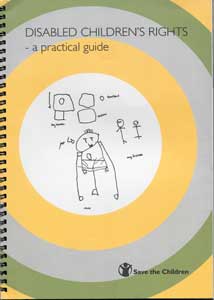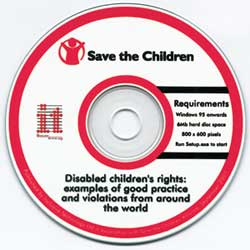Disabled Children’s Rights
Hazel Jones
Children all over the world continue to face inequality in their everyday lives. For many disabled girls and boys discrimination, abuse and lack of access to education are facts of life. Hazel Jones describes a project initiated by the International Save the Children Alliance Task Group on Disability and Discrimination. The project collected examples of good practice in implementing disabled children’s rights. By collecting these small-scale and isolated examples, the project aimed to combat the lack of information and understanding about disabled children’s lives.
The purpose of the project is to promote the rights of disabled children by:
- Improving people’s understanding about the situation of disabled children and the issues that affect them;
- Inspiring others by providing examples of what is already being done, with a focus on countries of the South;
- Providing practical and realistic steps for implementation.
The Task Group has collected over 400 pieces of information, from over 70 countries and from every continent.
The stories illustrate almost every Article of the Convention on the Rights of the Child (CRC):
- Right to survival and development: disabled children are less likely to survive childhood than other children;
- Right to family life and protection from cruelty and neglect: many are abandoned or neglected, or even removed from their families;
- Right to non-discrimination: laws and policies in many countries are based on out-dated discriminatory assumptions.
The right to education
The majority of examples collected (45%), relate to the right to education. This indicates that education is a high priority for disabled children and their families, but also that education is an issue where discrimination can be more easily identified and addressed than some other issues.
Violations
The project identified some key issues related to the abuse of disabled children’s right to education. Disabled children are often tolerated only if they can fit in to the education system, otherwise they may be segregated, or, more often, they are completely denied an education.
In many countries up to 98% of disabled children have no access to education. Yet for a disabled child, education can literally be a life line, more so than for a non-disabled child. It is the inaccessibility of the education system which leads to exclusion – outdated curriculum, rigid assessment criteria, poorly trained teachers, poor resources, inaccessible buildings.
Japan, Argentina, and many former Soviet bloc countries use medical assessments to determine whether or not a child is entitled to education – and if so, what kind of education. Often it is the impairment which determines the type of school the child will attend, if at all. The views of the parents and child, and the actual needs and abilities of the child are routinely ignored.
Examples were identified of ‘the right to education’ being implemented in isolation from other rights. For example, a disabled child who is rejected from, or is not doing well at her local school, may then be sent to a special school, often far from her family and community. This may be seen by some as good practice, because the child may be happy and receiving an education at the special school. However, by sending the child away, we have deprived the child of the care of her family. By accepting that the local school can reject the child, we are condoning discrimination. We need to apply the principle of the indivisibility of rights, and use the four guiding principles of the Convention as criteria of good practice:
- non-discrimination
- survival and development
- the best interests of the child
- the child’s right to have her/his opinion heard.
Discrimination in education exists in educational laws and policies, in the way the education system and schools work, and in the behaviour of professionals, communities and individual people.
|
Good or improving practice
The project collected many examples of the successful inclusion of disabled children at all levels: pre-school, primary, secondary and tertiary. These examples demonstrate that: |
|
|
|
Publication

A book and CD-Rom have now been published. The book is written in an informal and jargon-free style, with the aim of helping the reader to understand the relevance of the UN CRC to the situation of disabled children, and it suggests ideas for promoting their rights.
The CD-ROM contains the complete database compiled during the project, which can be searched, using keywords according to the interest and needs of the user. It can be used on any PC (not Mac) with Windows 95 onwards. It needs 6Mb hard disk space.
Disabled children’s rights: A practical guide
by Hazel Jones

International Save the Children Alliance. Published by Save the Children Sweden, 2001.
Prices:
Book: 120 Swedish krona (£8 GBP, $11.25 US);
CD-ROM: 80 Swedish krona (£5.35 GBP, $7.50 US).
For more information contact:
Save the Children Sweden,
Publishing,
107 88 Stockholm,
Sweden.
Fax: +46 8 698 9025
info@rb.se
